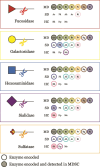Mucin-driven ecological interactions in an in vitro synthetic community of human gut microbes
- PMID: 39385462
- PMCID: PMC11632381
- DOI: 10.1093/glycob/cwae085
Mucin-driven ecological interactions in an in vitro synthetic community of human gut microbes
Abstract
Specific human gut microbes inhabit the outer mucus layer of the gastrointestinal tract. Certain residents of this niche can degrade the large and complex mucin glycoproteins that constitute this layer and utilise the degradation products for their metabolism. In turn, this microbial mucin degradation drives specific microbiological ecological interactions in the human gut mucus layer. However, the exact nature of these interactions remains unknown. In this study, we designed and studied an in vitro mucin-degrading synthetic community that included mucin O-glycan degraders and cross-feeding microorganisms by monitoring community composition and dynamics through a combination of 16S rRNA gene amplicon sequencing and qPCR, mucin glycan degradation with PGC-LC-MS/MS, production of mucin-degrading enzymes and other proteins through metaproteomics, and metabolite production with HPLC. We demonstrated that specialist and generalist mucin O-glycan degraders stably co-exist and found evidence for cross-feeding relationships. Cross-feeding on the products of mucin degradation by other gut microbes resulted in butyrate production, hydrogenotrophic acetogenesis, sulfate reduction and methanogenesis. Metaproteomics analysis revealed that mucin glycan degraders Akkermansia muciniphila, Bacteroides spp. and Ruminococcus torques together contributed 92% of the total mucin O-glycan degrading enzyme pool of this community. Furthermore, comparative proteomics showed that in response to cultivation in a community compared to monoculture, mucin glycan degraders increased carbohydrate-active enzymes whereas we also found indications for niche differentiation. These results confirm the complexity of mucin-driven microbiological ecological interactions and the intricate role of carbohydrate-active enzymes in the human gut mucus layer.
Keywords: Akkermansia; CAZymes; gut microbiota; mucin; synthetic community.
© The Author(s) 2024. Published by Oxford University Press.
Conflict of interest statement
None declared.
Figures










Similar articles
-
Distinct in vitro utilization and degradation of porcine gastric mucin glycans by human intestinal bacteria.FEMS Microbiol Ecol. 2025 Jul 14;101(8):fiaf066. doi: 10.1093/femsec/fiaf066. FEMS Microbiol Ecol. 2025. PMID: 40581599 Free PMC article.
-
Milk and mucin glycans orchestrate a synthetic infant gut microbiota structure.FEMS Microbiol Ecol. 2025 Jul 14;101(8):fiaf069. doi: 10.1093/femsec/fiaf069. FEMS Microbiol Ecol. 2025. PMID: 40560164 Free PMC article.
-
How microbial glycosyl hydrolase activity in the gut mucosa initiates microbial cross-feeding.Glycobiology. 2022 Mar 30;32(3):182-200. doi: 10.1093/glycob/cwab105. Glycobiology. 2022. PMID: 34939101 Free PMC article. Review.
-
Ruminococcus torques is a keystone degrader of intestinal mucin glycoprotein, releasing oligosaccharides used by Bacteroides thetaiotaomicron.mBio. 2024 Aug 14;15(8):e0003924. doi: 10.1128/mbio.00039-24. Epub 2024 Jul 8. mBio. 2024. PMID: 38975756 Free PMC article.
-
Mucin glycans and their degradation by gut microbiota.Glycoconj J. 2023 Aug;40(4):493-512. doi: 10.1007/s10719-023-10124-9. Epub 2023 Jun 15. Glycoconj J. 2023. PMID: 37318672 Review.
Cited by
-
A Biochemical View on Intermittent Fasting's Effects on Human Physiology-Not Always a Beneficial Strategy.Biology (Basel). 2025 Jun 9;14(6):669. doi: 10.3390/biology14060669. Biology (Basel). 2025. PMID: 40563920 Free PMC article. Review.
-
Distinct in vitro utilization and degradation of porcine gastric mucin glycans by human intestinal bacteria.FEMS Microbiol Ecol. 2025 Jul 14;101(8):fiaf066. doi: 10.1093/femsec/fiaf066. FEMS Microbiol Ecol. 2025. PMID: 40581599 Free PMC article.
-
Adaptive and metabolic convergence in rhizosphere and gut microbiomes.Microbiome. 2025 Jul 26;13(1):173. doi: 10.1186/s40168-025-02179-7. Microbiome. 2025. PMID: 40713710 Free PMC article. Review.
-
Interaction Between Microbiota and Immunity: Molecular Mechanisms, Biological Functions, Diseases, and New Therapeutic Opportunities.MedComm (2020). 2025 Jun 19;6(7):e70265. doi: 10.1002/mco2.70265. eCollection 2025 Jul. MedComm (2020). 2025. PMID: 40547945 Free PMC article. Review.
-
Milk and mucin glycans orchestrate a synthetic infant gut microbiota structure.FEMS Microbiol Ecol. 2025 Jul 14;101(8):fiaf069. doi: 10.1093/femsec/fiaf069. FEMS Microbiol Ecol. 2025. PMID: 40560164 Free PMC article.
References
-
- Acker L, Bergner KG, Diemair W, Heimann W, Kiermeier F, Schormüller J, Souci SW. Analytik der Lebensmittel, Nachweis und Bestimmung von Lebensmittel Inhaltsstoffen. In: Belitz H-D, Bergner K-G, Berndt D et al., editors. Handbuch der Lebensmittelchemie. Berlin, Germany: Springer Verlag; 1967.
-
- Andrews S. FastQC: a quality control tool for high throughput sequence data. 2010.
-
- Apprill A, Mcnally S, Parsons R, Weber L. Minor revision to V4 region SSU rRNA 806R gene primer greatly increases detection of SAR11 bacterioplankton. Aquat Microb Ecol. 2015:75(2):129–137.
MeSH terms
Substances
Grants and funding
LinkOut - more resources
Full Text Sources
Molecular Biology Databases
Miscellaneous

